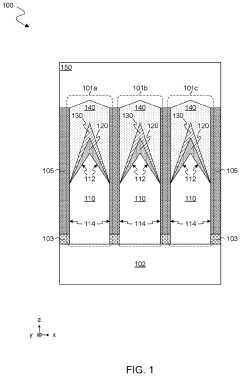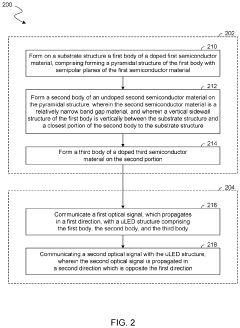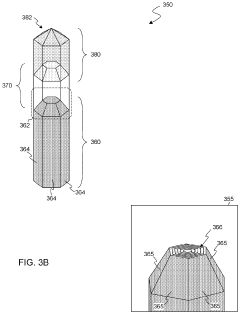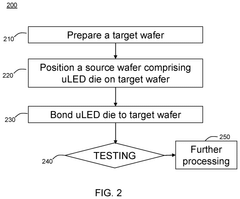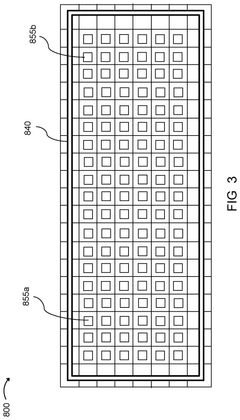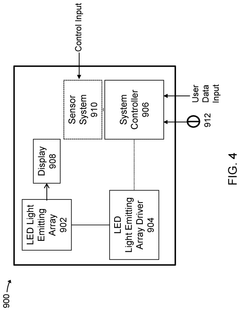Future Trends in ULED Television Technologies
JUN 23, 20259 MIN READ
Generate Your Research Report Instantly with AI Agent
Patsnap Eureka helps you evaluate technical feasibility & market potential.
ULED TV Evolution and Objectives
Ultra-LED (ULED) television technology has emerged as a significant advancement in display technology, building upon the foundation of LED and QLED technologies. The evolution of ULED TVs can be traced back to the early 2010s when manufacturers began exploring ways to enhance LED backlighting systems to improve picture quality, contrast, and color accuracy.
The primary objective of ULED technology is to deliver superior image quality while maintaining energy efficiency. This is achieved through a combination of advanced hardware and software innovations, including local dimming, quantum dot color enhancement, and high dynamic range (HDR) processing. As the technology has progressed, ULED TVs have consistently aimed to provide deeper blacks, brighter whites, and more vibrant colors than their predecessors.
One of the key milestones in ULED development was the introduction of full-array local dimming, which allowed for more precise control over backlight zones, significantly improving contrast ratios. This was followed by the integration of quantum dot technology, which expanded the color gamut and enhanced color accuracy. The incorporation of HDR capabilities further elevated the visual experience by increasing the dynamic range of displayed content.
Recent advancements in ULED technology have focused on increasing the number of local dimming zones, improving motion handling, and enhancing upscaling capabilities through AI-driven algorithms. These developments have resulted in ULED TVs that can display more nuanced gradations of light and color, reduce motion blur, and intelligently optimize content for the best possible viewing experience.
Looking ahead, the future trends in ULED television technologies are likely to revolve around several key areas. First, we can expect continued improvements in local dimming technology, potentially leading to pixel-level precision in backlight control. This would result in even better contrast and reduced blooming effects. Second, the integration of more advanced AI processors is anticipated, enabling real-time scene-by-scene optimization and enhanced upscaling of lower resolution content to 4K and 8K standards.
Additionally, the development of more efficient and brighter LED backlights is expected to push the boundaries of peak brightness while maintaining or improving energy efficiency. This could lead to ULED TVs that can deliver stunning HDR performance in both dark and bright viewing environments. Furthermore, advancements in quantum dot technology may result in wider color gamuts and improved color volume, bringing ULED displays closer to replicating the full spectrum of colors visible to the human eye.
The primary objective of ULED technology is to deliver superior image quality while maintaining energy efficiency. This is achieved through a combination of advanced hardware and software innovations, including local dimming, quantum dot color enhancement, and high dynamic range (HDR) processing. As the technology has progressed, ULED TVs have consistently aimed to provide deeper blacks, brighter whites, and more vibrant colors than their predecessors.
One of the key milestones in ULED development was the introduction of full-array local dimming, which allowed for more precise control over backlight zones, significantly improving contrast ratios. This was followed by the integration of quantum dot technology, which expanded the color gamut and enhanced color accuracy. The incorporation of HDR capabilities further elevated the visual experience by increasing the dynamic range of displayed content.
Recent advancements in ULED technology have focused on increasing the number of local dimming zones, improving motion handling, and enhancing upscaling capabilities through AI-driven algorithms. These developments have resulted in ULED TVs that can display more nuanced gradations of light and color, reduce motion blur, and intelligently optimize content for the best possible viewing experience.
Looking ahead, the future trends in ULED television technologies are likely to revolve around several key areas. First, we can expect continued improvements in local dimming technology, potentially leading to pixel-level precision in backlight control. This would result in even better contrast and reduced blooming effects. Second, the integration of more advanced AI processors is anticipated, enabling real-time scene-by-scene optimization and enhanced upscaling of lower resolution content to 4K and 8K standards.
Additionally, the development of more efficient and brighter LED backlights is expected to push the boundaries of peak brightness while maintaining or improving energy efficiency. This could lead to ULED TVs that can deliver stunning HDR performance in both dark and bright viewing environments. Furthermore, advancements in quantum dot technology may result in wider color gamuts and improved color volume, bringing ULED displays closer to replicating the full spectrum of colors visible to the human eye.
ULED Market Demand Analysis
The ULED (Ultra Light Emitting Diode) television market has been experiencing significant growth in recent years, driven by increasing consumer demand for high-quality, immersive viewing experiences. As consumers seek larger screens with better picture quality, ULED technology has emerged as a promising solution that offers superior brightness, contrast, and color accuracy compared to traditional LED and OLED displays.
Market research indicates that the global ULED TV market is poised for substantial expansion over the next decade. This growth is primarily fueled by the rising disposable income in developing economies, coupled with the increasing adoption of smart home technologies in developed markets. The demand for ULED TVs is particularly strong in regions such as North America, Europe, and Asia-Pacific, where consumers are more willing to invest in premium television technologies.
One of the key drivers of ULED market demand is the growing popularity of 4K and 8K content. As streaming platforms and broadcasters continue to produce and distribute ultra-high-definition content, consumers are increasingly seeking display technologies that can fully showcase these enhanced resolutions. ULED technology, with its ability to deliver exceptional picture quality and color accuracy, is well-positioned to meet this demand.
The gaming industry is another significant factor contributing to the growth of the ULED TV market. With the advent of next-generation gaming consoles and the increasing popularity of competitive gaming, there is a growing demand for displays that can offer high refresh rates, low input lag, and superior HDR performance. ULED technology addresses these requirements, making it an attractive option for gamers seeking immersive and responsive gaming experiences.
Furthermore, the trend towards larger screen sizes in home entertainment systems is driving demand for ULED TVs. As consumers opt for bigger displays to create cinema-like experiences at home, ULED technology's ability to maintain picture quality and brightness across larger screen sizes gives it a competitive edge in the market.
Environmental concerns and energy efficiency are also influencing consumer preferences in the TV market. ULED technology's improved energy efficiency compared to traditional LED backlit displays is appealing to environmentally conscious consumers and aligns with global efforts to reduce energy consumption.
However, the ULED market faces challenges from competing technologies such as OLED and MicroLED. While ULED offers advantages in terms of brightness and longevity, it must continue to innovate to maintain its market position. Manufacturers are investing in research and development to enhance ULED technology further, focusing on areas such as improved local dimming, wider color gamuts, and even thinner form factors.
Market research indicates that the global ULED TV market is poised for substantial expansion over the next decade. This growth is primarily fueled by the rising disposable income in developing economies, coupled with the increasing adoption of smart home technologies in developed markets. The demand for ULED TVs is particularly strong in regions such as North America, Europe, and Asia-Pacific, where consumers are more willing to invest in premium television technologies.
One of the key drivers of ULED market demand is the growing popularity of 4K and 8K content. As streaming platforms and broadcasters continue to produce and distribute ultra-high-definition content, consumers are increasingly seeking display technologies that can fully showcase these enhanced resolutions. ULED technology, with its ability to deliver exceptional picture quality and color accuracy, is well-positioned to meet this demand.
The gaming industry is another significant factor contributing to the growth of the ULED TV market. With the advent of next-generation gaming consoles and the increasing popularity of competitive gaming, there is a growing demand for displays that can offer high refresh rates, low input lag, and superior HDR performance. ULED technology addresses these requirements, making it an attractive option for gamers seeking immersive and responsive gaming experiences.
Furthermore, the trend towards larger screen sizes in home entertainment systems is driving demand for ULED TVs. As consumers opt for bigger displays to create cinema-like experiences at home, ULED technology's ability to maintain picture quality and brightness across larger screen sizes gives it a competitive edge in the market.
Environmental concerns and energy efficiency are also influencing consumer preferences in the TV market. ULED technology's improved energy efficiency compared to traditional LED backlit displays is appealing to environmentally conscious consumers and aligns with global efforts to reduce energy consumption.
However, the ULED market faces challenges from competing technologies such as OLED and MicroLED. While ULED offers advantages in terms of brightness and longevity, it must continue to innovate to maintain its market position. Manufacturers are investing in research and development to enhance ULED technology further, focusing on areas such as improved local dimming, wider color gamuts, and even thinner form factors.
ULED Tech Challenges
ULED (Ultra Light Emitting Diode) television technology, while promising significant advancements in display quality and energy efficiency, faces several technical challenges that need to be addressed for widespread adoption and continued innovation.
One of the primary challenges is the development of stable and efficient blue ULED materials. While red and green ULED materials have shown considerable progress, blue ULEDs still lag behind in terms of efficiency and longevity. This color imbalance affects the overall performance and color accuracy of ULED displays, limiting their potential to surpass existing technologies like OLED.
Another significant hurdle is the scalability of ULED manufacturing processes. Current production methods for ULED panels are complex and costly, making it difficult to achieve economies of scale necessary for mass market adoption. Developing more efficient and cost-effective manufacturing techniques, particularly for large-screen televisions, remains a critical challenge for the industry.
Heat management is also a major concern in ULED technology. As ULEDs are driven at high currents to achieve the desired brightness levels, they generate substantial heat. This can lead to decreased efficiency, shortened lifespan, and potential color shifts over time. Implementing effective thermal management solutions without compromising the slim profile of modern televisions is a significant engineering challenge.
The issue of color gamut and accuracy presents another technical obstacle. While ULEDs have the potential to offer a wider color gamut than traditional LED-LCD displays, achieving consistent and accurate color reproduction across the entire spectrum remains challenging. This is particularly important for high-end applications such as professional video editing and cinematic experiences.
Durability and lifespan of ULED displays also pose significant challenges. The organic materials used in some ULED configurations are susceptible to degradation over time, especially when exposed to oxygen and moisture. Developing robust encapsulation techniques and more stable materials is crucial for ensuring the long-term reliability of ULED televisions.
Additionally, the integration of ULED technology with other advanced display features, such as high refresh rates, HDR (High Dynamic Range), and 8K resolution, presents complex technical challenges. Balancing these features while maintaining energy efficiency and picture quality requires sophisticated hardware and software solutions.
Lastly, the environmental impact of ULED production and disposal is an emerging concern. As the technology advances, developing eco-friendly manufacturing processes and ensuring the recyclability of ULED components will become increasingly important, both from a regulatory and consumer perspective.
One of the primary challenges is the development of stable and efficient blue ULED materials. While red and green ULED materials have shown considerable progress, blue ULEDs still lag behind in terms of efficiency and longevity. This color imbalance affects the overall performance and color accuracy of ULED displays, limiting their potential to surpass existing technologies like OLED.
Another significant hurdle is the scalability of ULED manufacturing processes. Current production methods for ULED panels are complex and costly, making it difficult to achieve economies of scale necessary for mass market adoption. Developing more efficient and cost-effective manufacturing techniques, particularly for large-screen televisions, remains a critical challenge for the industry.
Heat management is also a major concern in ULED technology. As ULEDs are driven at high currents to achieve the desired brightness levels, they generate substantial heat. This can lead to decreased efficiency, shortened lifespan, and potential color shifts over time. Implementing effective thermal management solutions without compromising the slim profile of modern televisions is a significant engineering challenge.
The issue of color gamut and accuracy presents another technical obstacle. While ULEDs have the potential to offer a wider color gamut than traditional LED-LCD displays, achieving consistent and accurate color reproduction across the entire spectrum remains challenging. This is particularly important for high-end applications such as professional video editing and cinematic experiences.
Durability and lifespan of ULED displays also pose significant challenges. The organic materials used in some ULED configurations are susceptible to degradation over time, especially when exposed to oxygen and moisture. Developing robust encapsulation techniques and more stable materials is crucial for ensuring the long-term reliability of ULED televisions.
Additionally, the integration of ULED technology with other advanced display features, such as high refresh rates, HDR (High Dynamic Range), and 8K resolution, presents complex technical challenges. Balancing these features while maintaining energy efficiency and picture quality requires sophisticated hardware and software solutions.
Lastly, the environmental impact of ULED production and disposal is an emerging concern. As the technology advances, developing eco-friendly manufacturing processes and ensuring the recyclability of ULED components will become increasingly important, both from a regulatory and consumer perspective.
Current ULED Solutions
01 ULED display technology
ULED (Ultra Light Emitting Diode) technology is an advanced form of LED display used in televisions. It offers improved picture quality, enhanced brightness, and better contrast ratios compared to traditional LED displays. ULED TVs utilize local dimming techniques and quantum dot technology to achieve superior color reproduction and deeper blacks.- ULED display technology: ULED (Ultra Light Emitting Diode) technology is an advanced form of LED display used in televisions. It offers improved picture quality, enhanced brightness, and better contrast ratios compared to traditional LED displays. ULED TVs utilize local dimming techniques and quantum dot technology to achieve superior color reproduction and deeper blacks.
- Backlight control systems: ULED televisions incorporate sophisticated backlight control systems to optimize picture quality. These systems dynamically adjust the backlight intensity across different zones of the screen, enhancing contrast and reducing light bleed. Advanced algorithms are used to analyze incoming video signals and adjust the backlight accordingly, resulting in improved HDR performance and energy efficiency.
- Color enhancement techniques: ULED TVs employ various color enhancement techniques to deliver a wider color gamut and more accurate color reproduction. These may include quantum dot technology, advanced color management systems, and specialized color filters. The result is more vibrant and lifelike images with improved color accuracy across a broader spectrum of hues.
- Image processing and upscaling: Advanced image processing and upscaling technologies are integral to ULED televisions. These features use AI-powered algorithms to enhance lower resolution content, reduce noise, and optimize picture settings in real-time. The result is improved clarity, sharpness, and overall picture quality, especially when displaying non-4K or non-HDR content.
- Smart TV integration: ULED televisions often incorporate smart TV functionalities, integrating internet connectivity and various streaming services. These features allow users to access a wide range of content, use voice control, and interact with other smart home devices. The smart TV platforms in ULED TVs may also include AI-powered content recommendations and user interface optimizations.
02 Backlight control systems
ULED televisions incorporate sophisticated backlight control systems to optimize picture quality. These systems dynamically adjust the backlight intensity across different zones of the screen, enhancing contrast and reducing light bleed. Advanced algorithms are used to analyze incoming video signals and adjust the backlight accordingly, resulting in improved HDR performance and energy efficiency.Expand Specific Solutions03 Color enhancement technologies
ULED TVs employ various color enhancement technologies to deliver a wider color gamut and more accurate color reproduction. These may include quantum dot filters, advanced color management systems, and specialized color processing algorithms. The result is more vibrant and lifelike colors, with improved accuracy across the entire color spectrum.Expand Specific Solutions04 Image processing and upscaling
Advanced image processing and upscaling techniques are integral to ULED television technology. These systems use AI-powered algorithms to enhance lower resolution content, reduce noise, and improve overall picture clarity. They can also adjust various parameters such as sharpness, motion smoothing, and contrast enhancement in real-time to optimize the viewing experience.Expand Specific Solutions05 Smart TV features and connectivity
ULED televisions often incorporate smart TV features and advanced connectivity options. These may include built-in streaming platforms, voice control capabilities, home automation integration, and support for various wireless protocols. Such features enhance the overall user experience and allow for seamless integration with other smart home devices and content sources.Expand Specific Solutions
ULED Industry Leaders
The ULED television technology market is in a dynamic growth phase, characterized by rapid innovation and increasing competition. The industry is experiencing significant expansion, driven by consumer demand for higher-quality displays and immersive viewing experiences. Major players like Samsung Electronics, LG Electronics, and TCL China Star Optoelectronics are at the forefront of technological advancements, investing heavily in research and development. The market is witnessing a shift towards more energy-efficient and higher-resolution displays, with companies like Appotronics and Xiamen San'an Optoelectronics contributing to micro-LED and quantum dot technologies. As the technology matures, we're seeing increased collaboration between display manufacturers and semiconductor companies like Intel, indicating a trend towards more integrated and sophisticated ULED solutions.
TCL China Star Optoelectronics Technology Co., Ltd.
Technical Solution: TCL is advancing its QLED technology with its proprietary Mini-LED backlight technology, branded as OD Zero Mini-LED. This technology allows for thousands of local dimming zones, improving contrast and reducing blooming effects. TCL is also developing 8K resolution panels with AI-enhanced upscaling capabilities. Their latest TVs incorporate quantum dot technology for wider color gamut and higher peak brightness. TCL is investing in research for MicroLED and inkjet-printed QLED technologies for future ULED TV applications.
Strengths: Competitive pricing, advanced Mini-LED technology, and rapid innovation in display technologies. Weaknesses: Brand perception compared to more established premium brands, and potential quality control issues at lower price points.
Samsung Electronics Co., Ltd.
Technical Solution: Samsung has developed its QLED (Quantum Dot Light Emitting Diode) technology for ULED TVs. This technology uses quantum dots to enhance color accuracy and brightness. Samsung's latest Neo QLED TVs incorporate mini-LED backlighting for improved local dimming and contrast. They also feature AI-powered upscaling to enhance lower resolution content to near-4K or 8K quality. Samsung is also exploring MicroLED technology for future TV models, which promises even better picture quality and energy efficiency.
Strengths: Superior color accuracy and brightness, advanced AI upscaling, and innovative display technologies. Weaknesses: Higher cost compared to traditional LED TVs, and potential for screen burn-in with static images.
Key ULED Innovations
Micro light emitting diode structures for efficient communication of an optical signal
PatentPendingUS20240038735A1
Innovation
- The development of a micro-LED structure comprising a nanowire or nanopost configuration with a vertically stacked arrangement of doped and undoped semiconductor materials, including gallium nitride and indium gallium nitride, which facilitates efficient optical signal communication by preventing vertical sidewall deposition and promoting signal transmission through the top side, enabling a more compact and energy-efficient design.
Hybrid Bonding With Micro-Light Emitting Diode (LED) Devices
PatentPendingUS20250056921A1
Innovation
- The development of micro-light emitting diode (uLED) devices utilizing hybrid bonding techniques, which combine metal-to-metal and dielectric-to-dielectric bonds between a source wafer and a target wafer, to ensure reliable electrical communication and assembly.
ULED Energy Efficiency
Energy efficiency is a critical aspect of ULED (Ultra Light Emitting Diode) television technologies, and future trends indicate significant advancements in this area. As consumers become increasingly environmentally conscious and energy costs continue to rise, manufacturers are focusing on developing more energy-efficient ULED displays.
One of the primary trends in ULED energy efficiency is the improvement of light-emitting materials. Researchers are exploring new phosphor compositions and quantum dot materials that can convert blue light to other colors more efficiently. These advancements are expected to reduce energy loss during color conversion, resulting in brighter displays that consume less power.
Another promising direction is the development of micro-LED technology, which allows for more precise control of individual pixels. This granular control enables dynamic power management, where only the necessary pixels are illuminated at full brightness, while others can be dimmed or turned off completely. This approach can significantly reduce overall power consumption, especially in scenes with high contrast ratios.
Advanced local dimming techniques are also being refined to enhance energy efficiency. By dividing the screen into smaller zones and controlling the backlight for each zone independently, ULED TVs can achieve deeper blacks and higher contrast while reducing power usage in darker areas of the image.
The integration of artificial intelligence and machine learning algorithms is expected to play a crucial role in optimizing energy consumption. These systems can analyze content in real-time and adjust brightness, contrast, and color settings to maintain picture quality while minimizing power usage. Additionally, AI-driven power management systems can learn user viewing habits and automatically adjust settings to balance energy efficiency and viewing experience.
Improvements in driver circuitry and power supply units are also contributing to enhanced energy efficiency. More efficient voltage regulators and power distribution systems are being developed to reduce energy loss during power conversion and distribution within the TV.
Furthermore, the use of advanced heat management techniques is becoming increasingly important. As ULED displays become brighter and more powerful, efficient heat dissipation is crucial for maintaining performance and longevity while reducing the need for energy-intensive cooling systems.
Looking ahead, the integration of ambient light sensors and adaptive brightness technologies is expected to become more sophisticated. These systems will allow ULED TVs to automatically adjust their output based on room lighting conditions, further optimizing energy consumption without compromising viewing quality.
One of the primary trends in ULED energy efficiency is the improvement of light-emitting materials. Researchers are exploring new phosphor compositions and quantum dot materials that can convert blue light to other colors more efficiently. These advancements are expected to reduce energy loss during color conversion, resulting in brighter displays that consume less power.
Another promising direction is the development of micro-LED technology, which allows for more precise control of individual pixels. This granular control enables dynamic power management, where only the necessary pixels are illuminated at full brightness, while others can be dimmed or turned off completely. This approach can significantly reduce overall power consumption, especially in scenes with high contrast ratios.
Advanced local dimming techniques are also being refined to enhance energy efficiency. By dividing the screen into smaller zones and controlling the backlight for each zone independently, ULED TVs can achieve deeper blacks and higher contrast while reducing power usage in darker areas of the image.
The integration of artificial intelligence and machine learning algorithms is expected to play a crucial role in optimizing energy consumption. These systems can analyze content in real-time and adjust brightness, contrast, and color settings to maintain picture quality while minimizing power usage. Additionally, AI-driven power management systems can learn user viewing habits and automatically adjust settings to balance energy efficiency and viewing experience.
Improvements in driver circuitry and power supply units are also contributing to enhanced energy efficiency. More efficient voltage regulators and power distribution systems are being developed to reduce energy loss during power conversion and distribution within the TV.
Furthermore, the use of advanced heat management techniques is becoming increasingly important. As ULED displays become brighter and more powerful, efficient heat dissipation is crucial for maintaining performance and longevity while reducing the need for energy-intensive cooling systems.
Looking ahead, the integration of ambient light sensors and adaptive brightness technologies is expected to become more sophisticated. These systems will allow ULED TVs to automatically adjust their output based on room lighting conditions, further optimizing energy consumption without compromising viewing quality.
ULED Content Ecosystem
The ULED content ecosystem is rapidly evolving to support the advanced capabilities of Ultra LED television technologies. As ULED displays continue to push the boundaries of picture quality, content creators and distributors are adapting to leverage these advancements fully.
High Dynamic Range (HDR) content is becoming increasingly prevalent, with more studios and streaming platforms offering HDR-enabled movies, TV shows, and games. This trend is driven by the superior contrast and color range that ULED TVs can display, providing viewers with a more immersive and lifelike visual experience.
8K resolution content is also gaining traction, albeit at a slower pace than HDR. While 8K cameras and production equipment are becoming more accessible, the distribution infrastructure and consumer demand are still catching up. However, as ULED TVs with 8K resolution become more common, we can expect an increase in native 8K content production.
AI-enhanced upscaling is playing a crucial role in bridging the gap between existing content and ULED capabilities. Advanced algorithms are being developed to intelligently upscale lower resolution content to match the high pixel counts of ULED displays, ensuring that even older content can benefit from the improved display technology.
The gaming industry is also adapting to ULED technologies, with next-generation consoles and high-end PCs supporting features like variable refresh rates, auto low latency mode, and 4K/120Hz gameplay. This synergy between gaming hardware and ULED displays is creating new opportunities for immersive gaming experiences.
Virtual and augmented reality content is another area of growth within the ULED ecosystem. The high refresh rates, low latency, and superior color accuracy of ULED displays make them ideal for VR and AR applications, potentially expanding the use cases for large-format displays in both home and commercial environments.
Content delivery networks and streaming platforms are optimizing their infrastructure to handle the increased data demands of ULED-compatible content. This includes advancements in video compression technologies and the rollout of faster broadband and 5G networks to support the higher bitrates required for 4K and 8K HDR content.
As the ULED content ecosystem matures, we can expect to see more collaborations between display manufacturers, content creators, and technology providers. These partnerships will aim to create end-to-end solutions that ensure viewers can fully appreciate the capabilities of their ULED televisions, from content creation to final display.
High Dynamic Range (HDR) content is becoming increasingly prevalent, with more studios and streaming platforms offering HDR-enabled movies, TV shows, and games. This trend is driven by the superior contrast and color range that ULED TVs can display, providing viewers with a more immersive and lifelike visual experience.
8K resolution content is also gaining traction, albeit at a slower pace than HDR. While 8K cameras and production equipment are becoming more accessible, the distribution infrastructure and consumer demand are still catching up. However, as ULED TVs with 8K resolution become more common, we can expect an increase in native 8K content production.
AI-enhanced upscaling is playing a crucial role in bridging the gap between existing content and ULED capabilities. Advanced algorithms are being developed to intelligently upscale lower resolution content to match the high pixel counts of ULED displays, ensuring that even older content can benefit from the improved display technology.
The gaming industry is also adapting to ULED technologies, with next-generation consoles and high-end PCs supporting features like variable refresh rates, auto low latency mode, and 4K/120Hz gameplay. This synergy between gaming hardware and ULED displays is creating new opportunities for immersive gaming experiences.
Virtual and augmented reality content is another area of growth within the ULED ecosystem. The high refresh rates, low latency, and superior color accuracy of ULED displays make them ideal for VR and AR applications, potentially expanding the use cases for large-format displays in both home and commercial environments.
Content delivery networks and streaming platforms are optimizing their infrastructure to handle the increased data demands of ULED-compatible content. This includes advancements in video compression technologies and the rollout of faster broadband and 5G networks to support the higher bitrates required for 4K and 8K HDR content.
As the ULED content ecosystem matures, we can expect to see more collaborations between display manufacturers, content creators, and technology providers. These partnerships will aim to create end-to-end solutions that ensure viewers can fully appreciate the capabilities of their ULED televisions, from content creation to final display.
Unlock deeper insights with Patsnap Eureka Quick Research — get a full tech report to explore trends and direct your research. Try now!
Generate Your Research Report Instantly with AI Agent
Supercharge your innovation with Patsnap Eureka AI Agent Platform!
